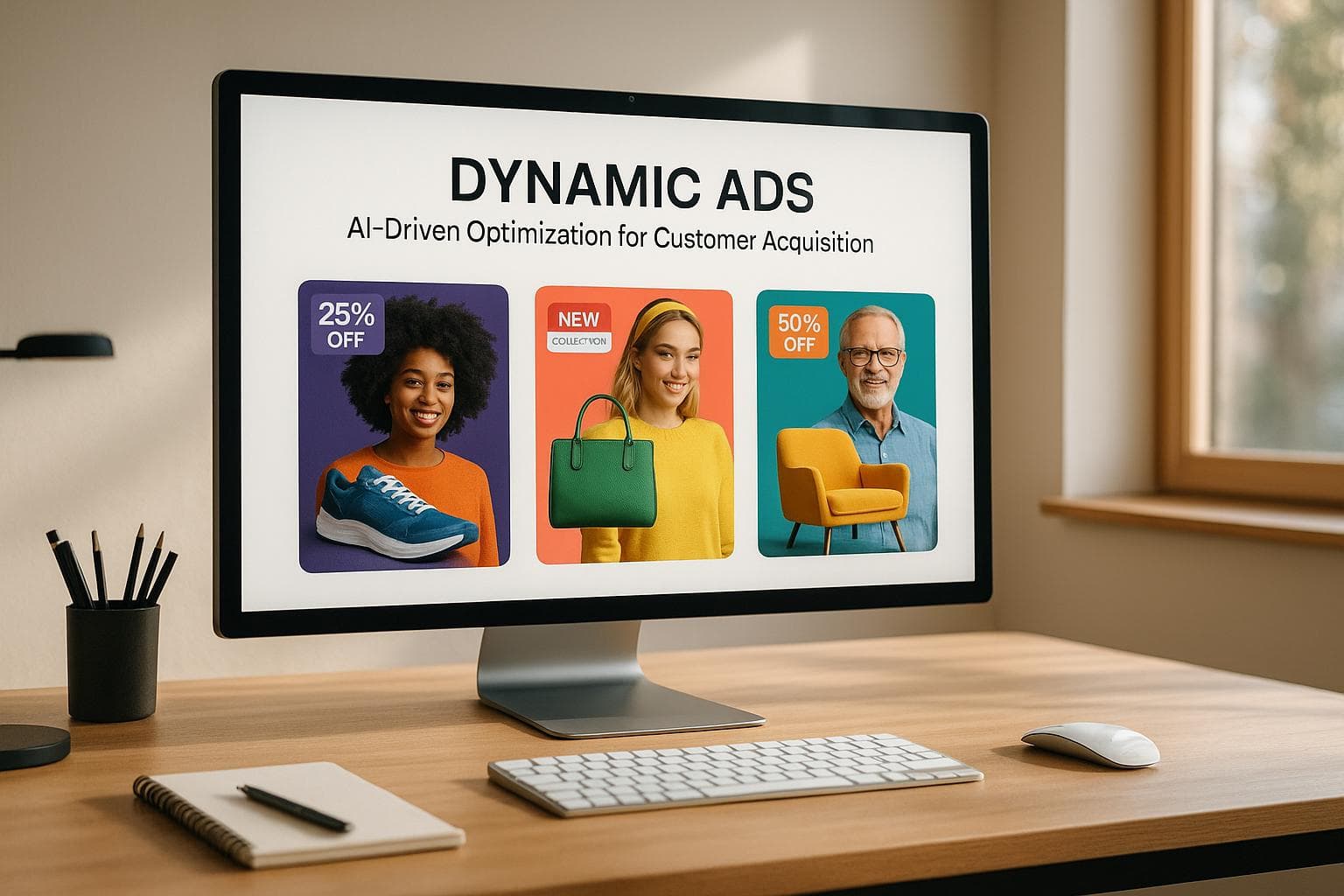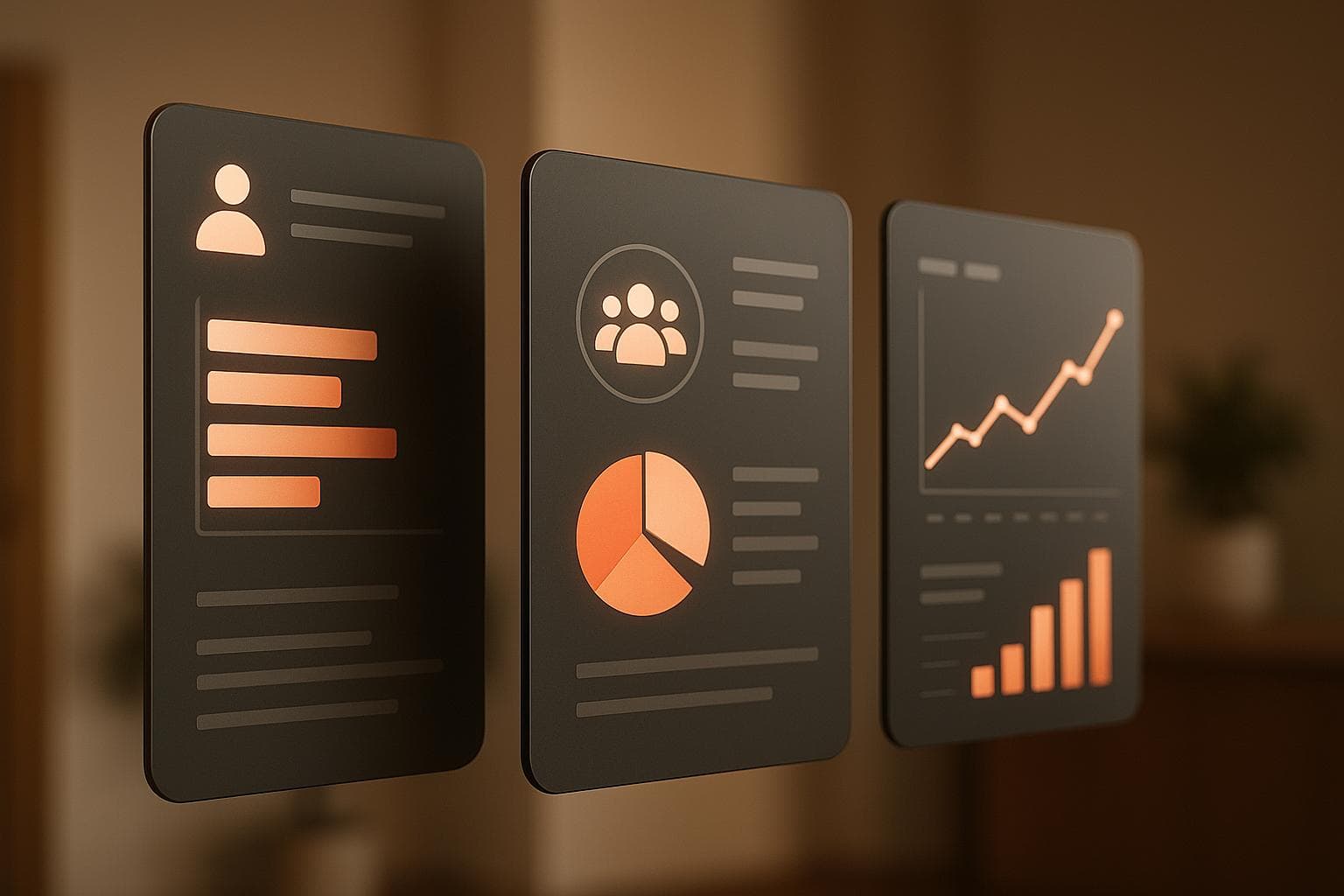Top 6 Marketing Automation Tools for Ecommerce Stores
Explore the top marketing automation tools for e-commerce, designed to enhance customer engagement and drive sales through automation.
Feedcast.ai: Fixes product feed issues, manages multichannel ads, and tracks performance with AI.
Omnisend: Combines email and SMS automation, driving up to 30% of sales.
ActiveCampaign: Offers personalized workflows and advanced analytics for email and cross-channel campaigns.
HubSpot Marketing Hub: AI-powered tools for ad targeting, predictive analytics, and multi-channel integration.
Drip: Focused on customer behavior with tailored workflows that increase revenue and retention.
Klaviyo: AI-driven email automation and segmentation with over 350 integrations.
Quick Comparison
| Tool | Key Features | Starting Price | Best For |
|---|---|---|---|
| Feedcast.ai | Product feed fixes, multichannel ads | Custom pricing | Ad management and optimization |
| Omnisend | Email + SMS automation | $16/month | Multi-channel marketing |
| ActiveCampaign | Visual workflows, analytics | $29/month | Personalized email campaigns |
| HubSpot Marketing Hub | AI ad targeting, predictive analytics | $50/month | Comprehensive marketing tools |
| Drip | Customer behavior workflows | $39/month | Data-driven campaigns |
| Klaviyo | Advanced email automation | Based on contacts | High-level personalization |
These tools automate repetitive tasks, improve customer engagement, and help e-commerce businesses grow. Choose the one that fits your needs and budget to get started!
Best Email Marketing Platforms for Ecommerce | Top 5 Tools for Automation & Sales
1. Feedcast.ai

Feedcast.ai is a marketing automation platform designed to simplify and improve how e-commerce businesses handle their advertising efforts. With AI-powered tools, it tackles common hurdles like product feed errors and inefficient campaign management, making it a valuable resource for online retailers.
One of its standout features is the ability to spot and fix product feed issues that could hurt ad visibility. For instance, shipping information errors account for 23.49% of product ad disapprovals, and about 10% of Magento listings have stock-related mistakes [5]. Feedcast.ai's validation system automatically detects these problems, ensuring products stay visible across advertising platforms.
The platform also excels in multichannel advertising management. Through a single dashboard, businesses can oversee campaigns across major platforms like Google, Facebook, Instagram, and Microsoft [4]. This unified approach reduces the hassle of switching between multiple interfaces, saving time and effort.
"After testing shopping campaigns without much success on my own, I tried Feedcast. Campaigns were quickly set up and the results quickly evolved in a very positive way. Additionally, the support is very responsive to any questions asked!"
– Léa Moller, CEO at Nid de Famille [4]
Feedcast.ai also prioritizes performance tracking with a focus on key e-commerce metrics. Its analytics dashboard provides real-time insights to help fine-tune campaigns:
| Metric | Measures | Automated Action |
|---|---|---|
| Click-Through Rate | User interest in your listings | Refines titles and descriptions for better engagement |
| Conversion Rate | Likelihood of purchase | Adjusts listing elements to boost sales |
| Search Term Data | Customer search behavior | Updates keywords and categorization |
| Bounce Rate | Content relevance to users | Improves product details to retain interest |
Beyond automation, Feedcast.ai enhances product data with AI-powered enrichment. It creates tailored ad copy and pinpoints potential buyers, helping businesses engage their audience more effectively. As industry analyst Bob Smith noted:
"Absolutely revolutionary, a game-changer for our industry. It has streamlined our processes and enhanced our productivity dramatically."
– Bob Smith, Industry Analyst [4]
The platform’s results speak for themselves. Antoine LEGUEZ, a Digital Project Manager, shared that he achieved his expected ROI within the first month of using Feedcast.ai, attributing the success to its ability to deliver fast and cost-effective outcomes [4].
Additionally, Feedcast.ai integrates seamlessly with popular e-commerce platforms like Shopify, WooCommerce, and Prestashop [6]. This compatibility, combined with its AI-driven features, makes it an effective tool for businesses looking to scale their advertising efforts with ease and efficiency.
2. Omnisend
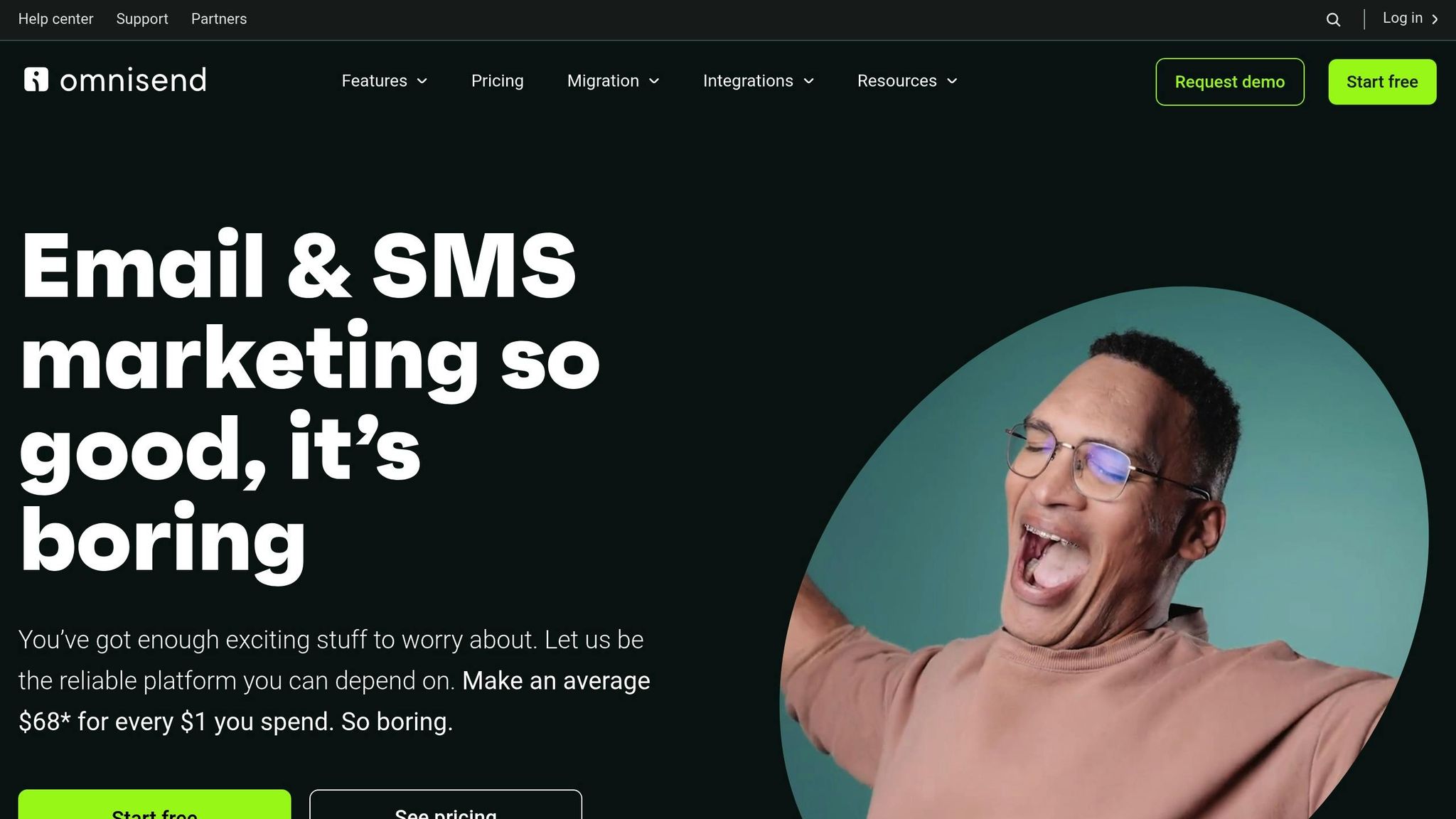
Omnisend is a marketing automation platform tailored for e-commerce businesses. It’s designed to deliver results, with automation accounting for 30% of sales and generating a $68 return for every $1 spent on email marketing [9][11]. Using pre-built workflows that align with different stages of the customer journey, Omnisend helps businesses achieve impressive outcomes. Let’s dive into some real-world examples of its impact.
Allison Caufield, Senior Marketing Manager at FiGPiN, highlights how automation has transformed their results:
"We see amazing results from our automated emails. Our cart abandonment especially stands out with an 87% conversion rate and $7.44 revenue per email." [7]
Omnisend’s performance across various marketing channels showcases its consistency and effectiveness:
| Channel | Key Metrics | Impact |
|---|---|---|
| 52% higher open rates | Automated emails drive 37% of sales despite making up just 2% of email volume | |
| SMS | 47.7% higher conversion rates | Performs even better when paired with email campaigns |
Kylie Porter-Wright, owner of Black Mango, shares her experience with Omnisend’s email capture tools:
"With just one hour invested (and zero financial input) into Omnisend's email capture features, our newsletter signups jumped by 150% in four weeks." [10]
Omnisend’s pricing starts at an accessible $16/month, and it offers integration with over 160 tools through flexible APIs [8][11]. Looking ahead, the platform is set to introduce a new reporting engine in January 2025. This feature will provide unified channel performance analysis, as Zygimantas Eirosius, Product Manager at Omnisend, explains:
"The new reporting engine will help our clients analyze their data more intuitively and make better decisions on their continual journey to increase revenue." [12]
3. ActiveCampaign
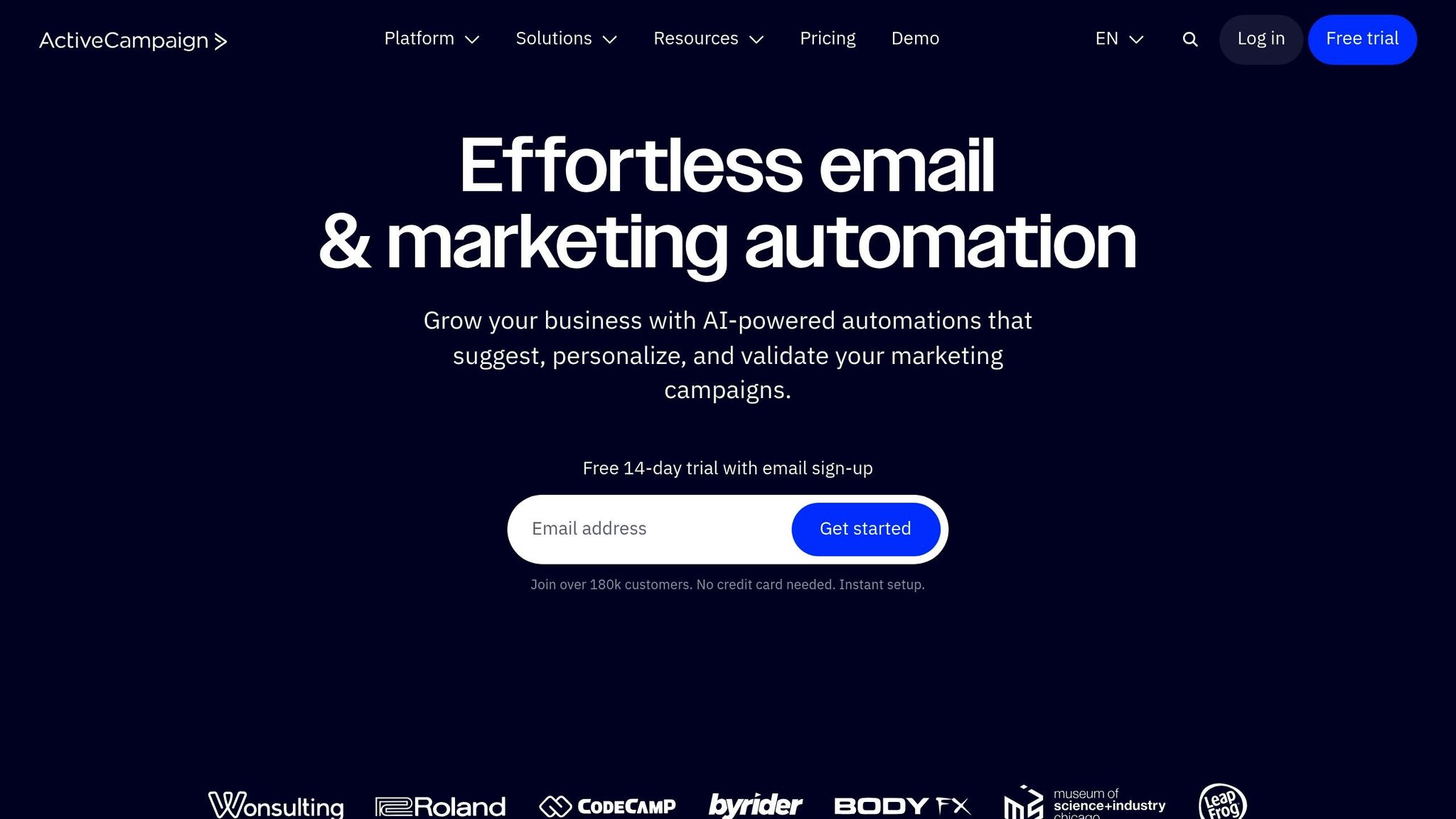
ActiveCampaign is a marketing automation platform designed to deliver impressive results for e-commerce businesses. With an email deliverability rate of 94.2% [14], it goes beyond standard email marketing by offering powerful automation tools.
One key feature is its visual automation builder, which allows merchants to design personalized workflows with ease. A great example is Morrow Audio, which used ActiveCampaign's automation to recover 26% of abandoned carts and generate $30,000 in revenue. As Morrow Audio's CEO shared:
"Even though I'm the CEO, president, and founder of Morrow Audio, because ActiveCampaign is so easy to use – I enjoy doing it! And the website is a selling machine. All I have to do is get people to show up and they buy." [13]
ActiveCampaign's cross-channel capabilities also delivered impressive outcomes for Pit Boss, which earned $76,717 from just two targeted email campaigns by leveraging forms, tagging, and automation [15][16].
Another success story comes from a biodegradable dog poop bag company that achieved a 73% email open rate through strategic automation. Their experience highlights the platform's ability to cater to both B2C and B2B needs:
"ActiveCampaign was the right option because it has a really strong B2C side, but it also has the B2B CRM as well. That's something you don't find in many CRM to do both sides really well." [17]
ActiveCampaign also excels in performance tracking, offering a range of tools to help e-commerce businesses measure and improve their efforts. Here's a breakdown of its tracking features:
| Tracking Feature | Benefits |
|---|---|
| Campaign Performance | Tracks e-commerce revenue, opens, clicks, and engagement metrics |
| Automation Analytics | Evaluates workflow effectiveness and sales engagement |
| Contact Trends | Monitors audience growth and segmentation success |
| Custom Dashboards | Compares key metrics side-by-side for actionable insights |
For businesses aiming to elevate their marketing automation, ActiveCampaign provides hundreds of pre-built automation templates [14]. It integrates effortlessly with popular e-commerce platforms like Shopify, WooCommerce, BigCommerce, and Magento [17].
In December 2024, the platform introduced an upgraded Campaigns Performance Report [18]. This update offers deeper analytics, helping businesses assess campaign effectiveness and ROI with greater precision.
Next, we’ll explore how HubSpot Marketing Hub complements these automation tools.
sbb-itb-0bd1697
4. HubSpot Marketing Hub
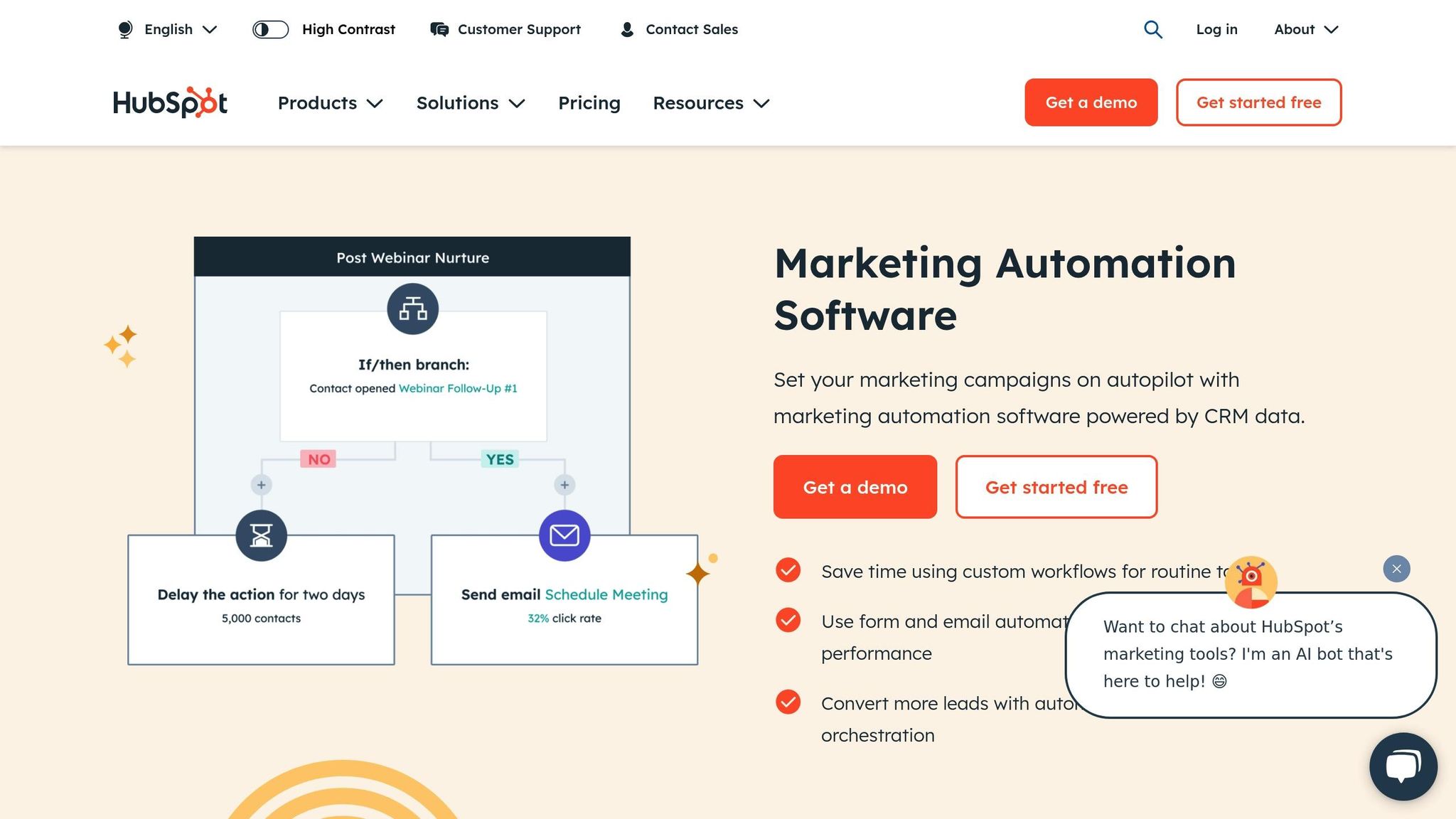
HubSpot Marketing Hub simplifies e-commerce marketing with a suite of AI-driven tools designed to make campaigns more efficient and effective [20]. One standout feature is its AI-powered ad targeting, which optimizes ad placements based on user behavior, ensuring smarter ad spending and better conversion rates [20].
The platform's impact is clear. For example, Cards Against Humanity reported a 45% revenue increase, closed 30% more deals, and boosted customer satisfaction by 20% after using HubSpot's tools [24].
Key Features and Benefits
HubSpot's Commerce Hub offers a range of tools that cater to different aspects of e-commerce marketing:
| Feature | Functionality | Business Impact |
|---|---|---|
| AI-Powered Ad Targeting | Adjusts ad placements based on user behavior | Optimized ad spend and conversions |
| Predictive Analytics | Provides real-time campaign tracking | Enables data-driven ROI decisions |
| Multi-Channel Integration | Centralizes marketing management across platforms | Ensures consistent brand messaging |
| Commerce Tools | Includes payment, invoicing, and subscription management | Simplifies transactions |
HubSpot's commitment to innovation is reflected in its leadership. CEO Brian Halligan highlighted the platform's evolution, saying:
"We've had a strong product year so far, that's raised the power of our Enterprise Tier, while also adding new products to the mix. This began in Q1 with the introduction of an entirely updated version of Marketing Hub Enterprise. With this relaunch came a ton of advanced features, including revenue attribution reporting, AI-powered A/B testing, and account-based marketing. Marketers can now start with us at an early stage and grow with us into a large scale-up, now that we've released this product."
- Brian Halligan, HubSpot CEO [19]
Real-World Success Stories
HubSpot's integrated commerce solutions have delivered measurable results for businesses:
The Nutritional Coaching Institute consolidated its payment tools using HubSpot, achieving a 40% year-over-year revenue increase while saving over three hours weekly on reporting tasks [23].
Apps Without Code eliminated the need for five separate tools, streamlining operations and saving over 10 hours monthly [23].
Advanced E-Commerce Marketing Features
HubSpot builds on its automation capabilities with features like:
Smart Content Optimization: AI recommends layouts, headlines, and calls-to-action to improve engagement.
Automated Email Marketing: Delivers personalized emails at optimal times for better results.
Predictive Lead Scoring: Analyzes customer behavior to prioritize leads effectively.
Revenue Attribution: Offers advanced reporting to directly connect marketing efforts to sales.
The platform integrates seamlessly with major e-commerce platforms such as Shopify, BigCommerce, and WooCommerce [22]. Its consumption-based pricing model, which includes a 0.75% platform fee when using Stripe, provides flexibility for businesses of all sizes [23].
A recent study found that 63% of marketing leaders using AI-enabled software reported increased ROI after implementation [21]. This highlights how intelligent automation is driving business growth and transforming marketing strategies.
Up next, we’ll explore how Drip takes automation to the next level.
5. Drip
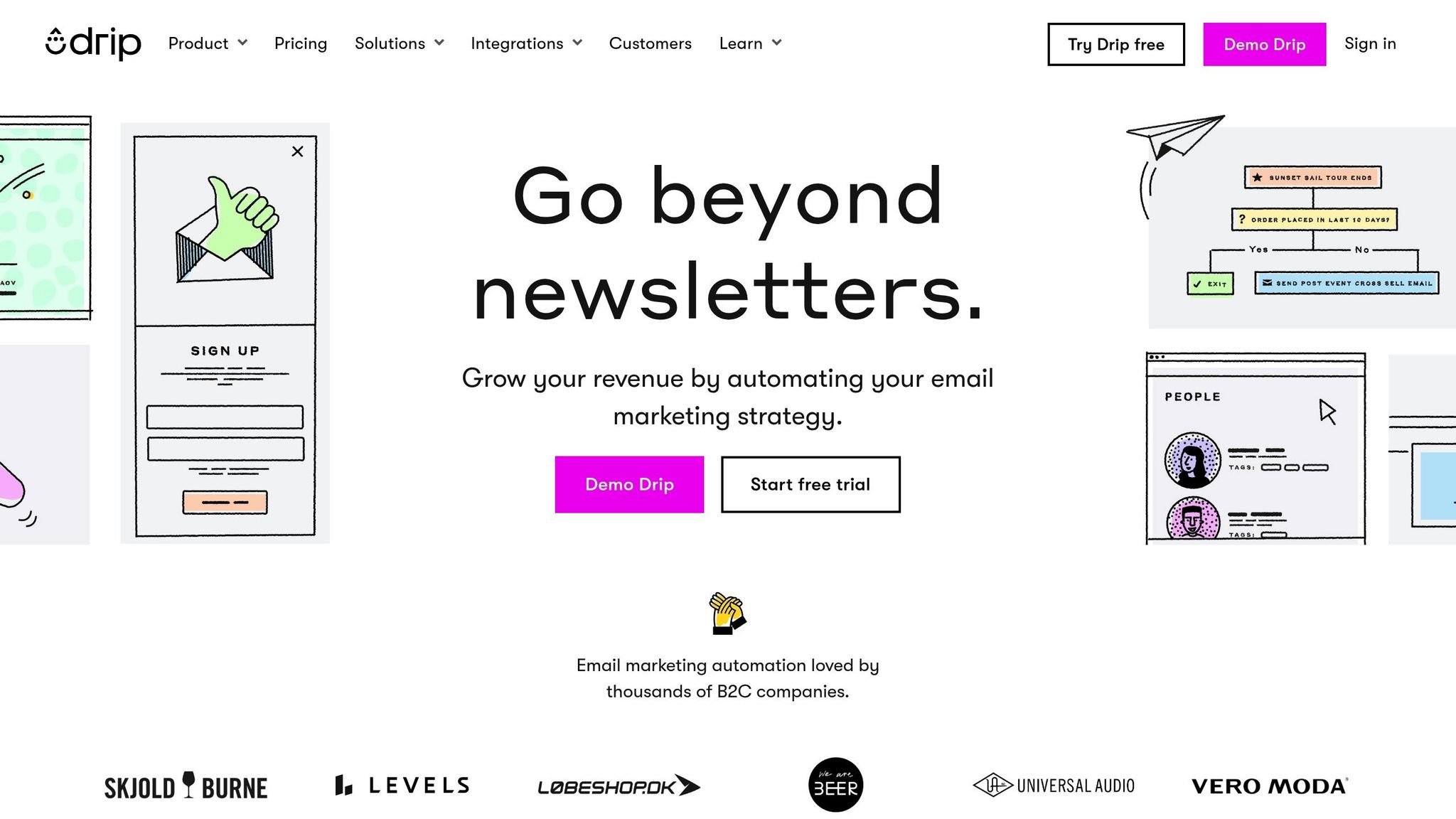
Drip takes ecommerce marketing to the next level with its AI-driven automation and data-focused approach. Designed specifically for online retailers, it simplifies marketing tasks while delivering measurable results.
Advanced Automation Capabilities
Drip uses customer behavior data to power tailored campaigns. Its visual workflow builder makes it easy for marketers to create detailed, multi-step campaigns that adapt to customer actions [28]. This automation system is part of a larger suite of tools aimed at driving revenue and improving efficiency.
| Campaign Type | Automation Features | Business Impact |
|---|---|---|
| Welcome Series | Personalized onboarding emails | Better customer engagement |
| Abandoned Cart | Recovery email sequences | Higher cart recovery rates |
| Post-Purchase | Follow-up campaigns | Stronger customer retention |
| Win-Back | Re-engagement strategies | Reactivated inactive customers |
Real-World Success Stories
Drip’s capabilities are backed by real-world results:
Nifty Gifts experienced a 77% revenue increase within just two months of using Drip. Their automated workflows also boosted average order values by as much as 122% [27].
Health Direct enhanced post-purchase engagement with Drip’s smart workflows:
"Drip has been a solid backbone to build excellent post-purchase automation. Their workflows also allow us to build 'intelligent' campaigns instead of just sending a series of emails that is responsive to customers' decisions and preferences." [26]
Multi-Channel Integration
Drip integrates with over 50 ecommerce platforms, including major players in the industry [26]. This allows for real-time customer data syncing, automated purchase tracking, and personalized messaging - all through a single, unified system.
Revenue-Boosting Features
Drip’s segmentation tools help businesses drive revenue by responding dynamically to customer actions [27]. Key features include:
Customer-Action Triggers: Sends targeted messages based on browsing or purchasing behavior [26].
Facebook Custom Audience Sync: Aligns email segments with social media campaigns [26].
Dynamic Segmentation: Automatically updates customer groups based on behavior patterns.
Revenue Attribution: Tracks how marketing efforts influence sales [25].
Pricing Structure
Drip offers flexible, subscriber-based pricing that grows with your business:
Entry-level plan: Starts at $39/month for up to 2,500 subscribers [25].
Advanced plan: Costs $1,299/month for 105,001–110,000 subscribers [25].
All plans include email marketing, SMS capabilities, automation workflows, and reporting tools [28]. This scalable pricing ensures businesses of all sizes can benefit from Drip’s features.
Email marketing expert Inka Wibowo from Email Tool Tester highlights Drip’s ecommerce focus:
"Drip is perhaps the easier of the two to master, and is excellent for ecommerce automations… [it's] been purpose-built for ecommerce." [26]
6. Klaviyo
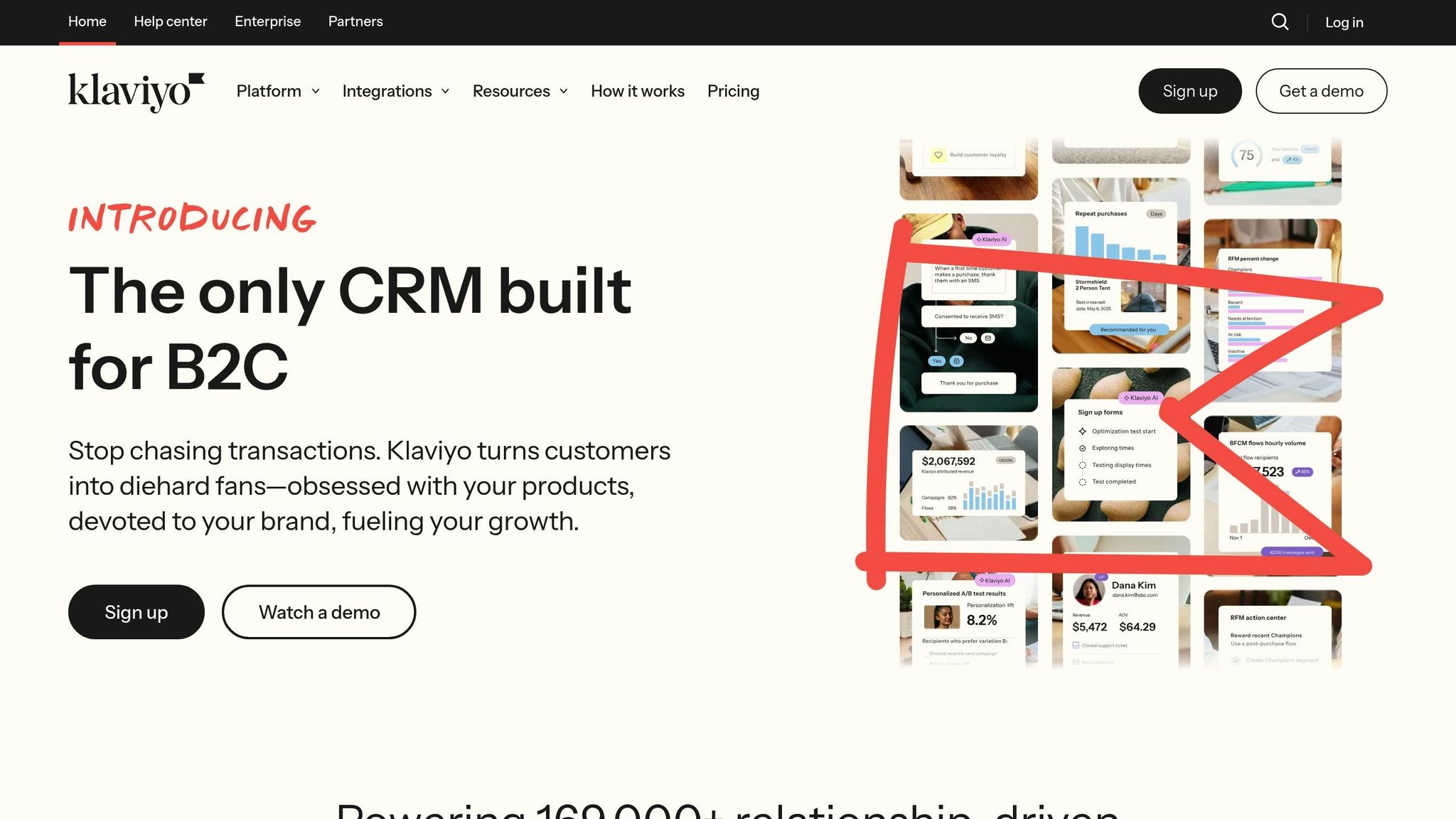
Klaviyo is reshaping e-commerce marketing with its AI-driven solutions. Trusted by over 169,000 customers and handling 2 billion daily events [31], it’s a go-to platform for online retailers seeking measurable results.
AI-Powered Marketing Automation
Powered by AI technology from OpenAI and AWS Bedrock [29], Klaviyo offers tools that simplify email automation and customer segmentation. Here’s how its key features deliver value:
| AI Feature | Function | Impact |
|---|---|---|
| Predictive Analytics | Forecasts customer behavior | Enables targeted campaigns |
| Smart Content | Generates email and SMS copy | Boosts engagement |
| A/B Testing | Optimizes campaign elements | Drives conversion growth |
| Send Time | Adjusts delivery timing | Increases open rates |
These AI tools work seamlessly with Klaviyo’s integrations, making it a powerful marketing ally.
Revenue-Boosting Integration
With over 350 pre-built integrations [30], Klaviyo delivers impressive outcomes, including:
Average ROI: 228% (Forrester, 2023) [31]
Black Friday/Cyber Monday Performance: $59.8M in attributed value in 2023 [31]
Automated Email Results: 16x higher revenue per recipient compared to manual campaigns [32]
Advanced Personalization for Better Engagement
Klaviyo’s personalization features take customer engagement to the next level. During the 2023 holiday season, businesses using the platform saw:
A 17% increase in average click rates
A 40% boost in average order conversion rates [34]
Real-World Success Stories
The Willow Tree Boutique showcases the power of Klaviyo's predictive analytics. By leveraging behavioral data, they targeted high-value customers:
"Behavioral targeting means taking the entirety of customer behavior, and personalizing communication based on that." - Jon Palmer, Lead Product Marketing Manager at Klaviyo [35]
For instance, they focused on customers with:
Predicted Customer Lifetime Value (CLV) over $500
Average Order Value (AOV) over $150
This strategy led to a 53.1% increase in revenue during the second half of 2023 [34].
Smart Campaign Optimization
Klaviyo’s campaign tools further refine marketing efforts with features like:
Sentiment analysis for reviews
Dynamic product recommendations
Industry benchmarks for performance comparison
AI-generated marketing sequences [36]
As Joseph Hsieh, Founder of Retention Commerce, explains:
"Once you understand that anything you put in the database - both from a behavior standpoint and from a profile property standpoint - can drive different experiences, the possibilities become endless" [33].
These capabilities make Klaviyo an essential tool for any e-commerce business looking to simplify and supercharge its marketing efforts.
Pricing Structure
Klaviyo’s pricing is based on the number of contacts, scaling alongside business growth. This structure ensures e-commerce businesses can achieve a strong return on investment while focusing on expanding their reach and deepening customer relationships.
Conclusion
E-commerce marketing automation is reshaping the industry, driving a 451% increase in qualified leads and boosting revenue by 40% through personalization [1][3].
Impact on E-commerce Operations
These numbers highlight how automation is changing the game across various business areas:
| Area | Impact | Timeline |
|---|---|---|
| Sales Productivity | 14.5% increase | Short-term |
| Marketing Overhead | 12.2% reduction | Medium-term |
| Lead Value | 47% larger purchases | Long-term |
| Campaign Personalization | 202% higher conversion | Immediate |
Strategic Implementation
Such advancements make it clear why selecting the right automation tool is crucial. Platforms like Feedcast.ai stand out by offering AI-powered product enrichment, seamless multichannel advertising, and performance optimization - all while significantly reducing costs, especially on Google Shopping CPC [4].
Future-Proofing Your E-commerce Strategy
The marketing automation sector is projected to grow by 38.2% between 2021 and 2024, reaching a market value of $6.62 billion [2]. This growth brings tangible benefits, including:
80% increase in lead generation
49% reduction in time spent on routine tasks
45% boost in marketing ROI [2]
"We needed an effective SEA solution, and Feedcast was able to meet our request quickly and at a low cost. This is the first month we have worked with Feedcast, and the return on investment is as expected!" - Antoine LEGUEZ, Digital Project Manager [4]
Making the Right Choice
Feedcast.ai demonstrates how the right automation tool can deliver fast returns while simplifying campaign management. The metrics above highlight the importance of tools that offer:
Easy integration with existing e-commerce platforms
Scalability to keep up with business growth
Reliable expert support
Proven ROI potential
With 80% of consumers more inclined to buy from brands that provide personalized experiences [37], leveraging automation allows e-commerce businesses to improve efficiency while meeting the demand for tailored customer interactions.
FAQs
How can I choose the right marketing automation tool for my e-commerce store?
Choosing the best marketing automation tool for your e-commerce store starts with understanding your specific business goals and challenges. Think about essential factors like how well the tool integrates with your existing systems (such as your CRM or e-commerce platform), its pricing structure, and key features like AI-powered insights, analytics, and campaign management tools.
You’ll also want to consider how easy the tool is to use, its customization options, and whether it fits smoothly into your team’s workflow. Prioritize solutions that cater to core e-commerce needs, including customer targeting, optimizing product feeds, and tracking ad performance. By carefully evaluating these elements, you can select a tool that helps drive your marketing efforts forward.
What are the main advantages of using AI-powered tools like Feedcast.ai to manage multichannel advertising campaigns?
AI-powered tools such as Feedcast.ai make multichannel advertising more efficient by taking over complex tasks like creating ads, targeting the right audience, and fine-tuning performance. Using real-time data, these tools can adjust campaigns instantly, ensuring your ads connect with the right people at the perfect moment.
By sending tailored messages across various platforms, these tools not only enhance customer engagement but also drive higher conversion rates and build lasting loyalty. Plus, they free up valuable time and resources, letting e-commerce businesses concentrate on strategy and growth while the tool takes care of managing campaigns.
How can a marketing automation tool improve the efficiency and ROI of my e-commerce store?
Using a marketing automation tool can make a big difference for your e-commerce store. By automating repetitive tasks, these tools free up your team to focus on more impactful activities, cutting down on manual work and lowering overhead costs.
They also open the door to personalized marketing campaigns that connect with your customers on a deeper level. This not only improves conversion rates but also drives more sales. With the help of data-driven insights, you can target the right audience, use your resources wisely, and see better outcomes overall. In short, automation tools can streamline your operations and boost your store's profitability.
Yohann B.

